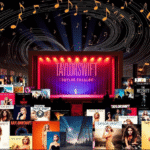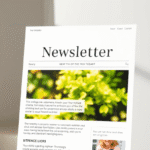Table of Contents
Are you ready to share your passions with the world? Starting a blog can be rewarding. But, it’s key to know the essential steps for success. In this guide, we’ll cover everything to kickstart your blogging journey and build a thriving online presence.
Ever wondered what makes successful bloggers stand out? The secret is finding a profitable niche, using the right tools, and creating captivating content. But, where do you start? What’s the key to unlocking your blogging potential and standing out in a crowded digital landscape?

Key Takeaways
- Discover your niche by aligning your passions with market demands
- Navigate the world of blogging platforms and choose the one that best fits your needs
- Secure a memorable domain name and reliable hosting to establish your online presence
- Design a visually appealing and user-friendly blog to captivate your audience
- Craft engaging content that resonates with your readers and establishes your expertise
- Implement effective promotion strategies to drive traffic and grow your blog’s visibility
- Explore monetization opportunities to turn your passion into a profitable venture
Choose Your Blog Niche
Choosing the right niche is key to a successful blog. It defines your content focus and affects your audience, earning potential, and success.
Research Popular and Profitable Niches
Start by looking into popular and profitable topics you’re interested in. Use tools like Google Trends, Semrush, and Ahrefs to find trending keywords and competitive niches. This helps you spot opportunities and see if a niche is worth entering.
Align Your Passion with Market Demand
Profitability is important, but so is choosing a niche you love. Successful bloggers create engaging content for a long time. By mixing your passion and expertise with what people want, you’ll build a thriving blog.
Evaluate Competition in Your Chosen Niche
After finding a promising niche, check out the competition. Look at top blogs in your field to see their strategies, audience interaction, and how they make money. This helps you find unique angles and offer something different to your readers.
| Key Factors to Consider When Choosing a Niche | Explanation |
|---|---|
| Passion and Expertise | Choose a niche you love and know well. This ensures your content is always top-notch and engaging. |
| Market Demand | Pick a niche with a big and growing audience. They should be looking for the content you plan to create. |
| Monetization Potential | Think about how you can make money in your niche. This could be through ads, affiliate marketing, or selling your own stuff. |
| Competitive Analysis | Study the competition in your niche. This helps you find what’s missing, stand out, and offer something unique. |
By thinking carefully about these points, you’ll pick a niche that leads to long-term success.
Select a Blogging Platform
Choosing the right blogging platform is a key decision when starting it. It affects your blog’s functionality, design, and user experience. Let’s look at some popular platforms and their differences.
Compare Popular Platforms (WordPress, Blogger, Wix)
WordPress, Blogger, and Wix are top choices for blogging. Each has unique features and capabilities:
- WordPress: Seen as the most versatile and powerful, WordPress offers lots of customization, plugins, and a big community.
- Blogger: Owned by Google, Blogger is great for beginners. It’s easy to use and perfect for starting your online journey.
- Wix: Wix is a website builder with blogging features. It’s known for its drag-and-drop interface and many templates, ideal for design-focused bloggers.
Understand the Differences Between Hosted and Self-Hosted Options
Choosing between hosted and self-hosted platforms is important:
- Hosted Platforms: Platforms like Blogger and Wix handle hosting. They’re easy to set up but offer less customization and content ownership.
- Self-Hosted Platforms: WordPress is self-hosted, offering more control over your blog. But, you’ll need to manage hosting and domain yourself, which can be more challenging.
Consider Long-Term Scalability and Flexibility
Think about your blog’s future growth when choosing a platform. Self-hosted platforms like WordPress are better for growth. They let you add advanced features and e-commerce as your blog grows. Picking the right platform from the start is crucial for your blog’s success and adaptability.

“The choice of a blogging platform is a critical decision that can significantly impact the success and growth of your online presence.”
Secure a Domain Name and Hosting
Starting your blog online means getting a good domain name and hosting. These are key parts of your blog’s foundation. Let’s look at some tips to help you choose well.
Tips for Choosing a Memorable Domain Name
Your domain name is your blog’s address on the web. It should be easy to remember and match your brand. Here are some tips:
- Keep it short, simple, and easy to spell
- Incorporate keywords related to your blog’s niche or topic
- Avoid using hyphens or numbers, as they can be difficult to remember
- Research availability and avoid names that are too similar to existing domains
- Consider using a top-level domain (TLD) like .com, .net, or .org for maximum credibility
Compare Hosting Providers and Plans
Choosing the right hosting is key for your blog’s success. Look at these factors when comparing:
- Server uptime and reliability
- Storage space and bandwidth limits
- Customer support and troubleshooting assistance
- E-commerce and e-mail capabilities, if needed
- Scalability and the ability to accommodate your blog’s growth
Bluehost, GoDaddy, and SiteGround are popular choices. They offer plans for different budgets and needs. Pick a plan that fits your needs for a smooth blogging experience.
Set Up Your Domain and Hosting
After picking your domain and hosting, set them up. This involves:
- Register your domain name with a registrar (may be provided by your hosting provider)
- Set up your hosting account and connect it to your domain
- Configure your website settings, such as email addresses and nameservers
- Install your blogging platform (e.g., WordPress) and set up your initial website structure
By following these steps, you’ll have a solid base for your blog. You’re ready to move forward.
Design Your Blog
Creating a blog that’s both engaging and easy to use is key to keeping readers. We’ll look at the important parts of making your blog look great and work well.
Choose and Customize a Theme
Pick the theme that fits your niche and brand. Make sure it’s good on all devices and easy to customize.
Create Essential Pages
Your blog needs a few main pages to share important info with readers. These pages are:
- About – Tell your story and why you want to connect with your audience.
- Contact – Let readers easily get in touch with you.
- Privacy Policy – Explain how you handle visitor data to follow the law.
Optimize Layout for User Experience
How you arrange your blog matters a lot. Make sure it’s easy to navigate and looks good. It should work well on phones and load fast to keep readers interested.
| Layout Element | Best Practices |
|---|---|
| Navigation Menu | Keep it simple and consistent, with clear category labels |
| Sidebar | Include relevant widgets, social media links, and email signup forms |
| Imagery | Use high-quality, visually compelling images to break up text |
| Readability | Optimize font size, line spacing, and paragraph structure for easy scanning |
By designing it well, you’ll make it a place readers want to visit again and again.
Create Engaging Content
As a blogger, your main goal is to grab your audience’s attention with interesting and useful content. Making your content engaging is crucial for building a loyal following. It also helps make your blog a trusted source of information. We’ll look at how to create a content strategy, write your first post, and use different content types to keep your readers interested.
Develop a Content Strategy
A good content strategy is the base of a successful blog. First, figure out who your audience is and what they care about. This helps you make content that speaks to them and meets their needs. Do some keyword research to find out what your audience is looking for. Then, use this info to plan your content calendar.
Write Your First Blog Post
Writing your first blog post can feel overwhelming, but it’s a key step. Pick a topic that fits your niche and what your audience likes. Make a title that grabs their attention and makes them want to read more. Your post should have a clear intro, body, and conclusion. Make sure your writing is engaging, informative, and easy to follow.
Incorporate Various Content Types
To keep your blog interesting and varied, try different content types. For example:
- Text-based articles that offer deep analysis and expertise
- Images that make your content more appealing and engaging
- Videos that let you connect with your audience in a fun way
- Infographics that show complex info in a clear and attractive way
- Interviews with experts that give unique views and insights
By mixing up your content, you can reach different learning styles and keep your readers coming back for more.
“Content is king, but engagement is queen, and the lady rules the house.” – Mari Smith
Promote Your Blog
Having a strong online presence is key for success. To draw more readers, use a mix of strategies. Here are three important ways to promote your blog.
Implement SEO Best Practices
SEO is vital for any blog’s success. It helps your blog show up more in search results. This means:
- Find the right keywords for your niche
- Use these keywords in your titles, descriptions, and content
- Make sure your site works well on mobile and loads fast
- Get backlinks by guest posting on other blogs
Leverage Social Media Platforms
Social media is great for promoting and connecting with readers. Pick the platforms that fit your niche and audience. A good social media plan includes:
- Create branded social media profiles
- Share your blog posts and talk to your followers
- Work with other bloggers and influencers
- Join online communities and discussions
Network with Other Bloggers and Influencers
Connecting with others in your field can help you reach more people. Here’s how to do it:
- Comment on other blogs and share their posts
- Ask to collaborate on guest posts or projects
- Go to industry events and meet people
- Join online forums and communities
By using these strategies, you can promote your blog well. This will help you grow your audience and make your content more successful. Remember, keep working hard and be smart in your approach to grow your blog’s online presence.
Monetize Your Blog
As your blog grows, it’s time to think about making money. Look into different ways to make money, like ads, affiliate marketing, or selling your own stuff. This can match your content and what your readers like.
Explore Different Monetization Methods
Look into many ways to make money to spread out your income. You can use ads, affiliate marketing, sponsorships, or sell digital or physical products. Think about what your audience likes to find the best way to make money from your blog.
Implement Ads and Affiliate Marketing
Adding ads to your blog, like Google AdSense, can bring in steady money. Also, look into affiliate marketing with brands that fit your content. Pick affiliate programs that are a good match for your blog and offer value to your readers.
Create and Sell Your Own Products or Services
Use your knowledge and the trust you’ve built to sell your own stuff. This could be e-books, online courses, coaching, or even merchandise. Make sure to research what people want and offer high-quality products that meet their needs.
FAQ
What is the best way to choose a profitable blog niche?
To pick a profitable niche, start by thinking about what you love. Look at what’s popular and trending. Also, check out how much competition there is. It’s important to find a niche that you’re passionate about and that people want to read about.
What are the differences between hosted and self-hosted blogging platforms?
Hosted platforms like Blogger and Wix are easy to set up. But, they don’t let you customize much. On the other hand, self-hosted platforms like WordPress give you more control over design and growth. However, they need more technical work to set up and manage.
How can I create a visually appealing blog design?
For a great blog design, pick a theme that works on all devices. Customize the look and colors to match your style. Make sure your content is easy to read and find. Adding high-quality images and graphics can also make it look better.
What are some effective ways to promote my blog and grow my audience?
To get more people to read your blog, use SEO well. Use social media to your advantage. Connect with other bloggers and influencers in your field. Also, make content that people want to share.
How can I monetize my blog and turn it into a profitable venture?
You can make money from your blog in many ways. Try ads and affiliate marketing. Sell your own products or services. Look for sponsorships and partnerships too. The goal is to find what works best for your blog and readers.










